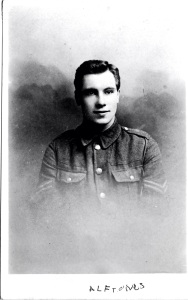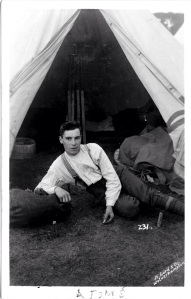Tags
Alfred Tonks, Cannock Road, Elsie Ricketts, epidemic, Express & Star, flu, France, Frederick Road, South Staffordshire Regiment
This blog post was prepared by volunteer, Frank Lockley.
***************************
Alfred Tonks was born in Barnsley in 1894. In the 1901 census he is shown as living in Cannock Road Wolverhampton with his grandmother Phoebe and family. In 1911 he is living at 20 Frederick Road, and working as an apprentice plumber. 
He joined the 6th Territorial Battalion South Staffordshire Regiment in 1911, and his service records show that he attended training camps of 2 weeks each in 1911, 1912 and 1913.
He was promoted to Lance Corporal in July 1914, then Corporal in Feb 1915. He served in France 5 March 1915 to 9 June 1915, and discharged on 4 Feb 1916 due to the “termination of the period of engagement”. As he had suffered a gunshot wound to the head, and was hospitalised in London for 5 days from 10 June 1915, he did not sign up again. Following his discharge Alfred was awarded a pension of 12 shillings a week for 12 months from 27 Dec 1917. The award sheet for a disablement pension shows that he was assessed as “this man’s incapacity in the general labour market is lessened by 40% for 12 months”
Alfred married Elsie Ricketts on 3 June 1918 at Holy Trinity. They had a son, Arthur, in October of that year but Alfred died on 31st October 1918 and was buried on 4 November in a family grave, together with his son Arthur aged just 16 days. Their address is given as Graisley Lane, Wednesfield.

Alfred Tonks in a Bell Tent (photographer H. Lord and Co.)
It is possible that both Alfred and Arthur were victims of the flu epidemic. The following week, the Express & Star reported that there had been 40 deaths from flu in the town that week, a figure that indicated the epidemic was on the point of subsiding and had reached its peak. However, Elsie’s son from her second marriage, Ken, believed that Alfred was shot in the head by a stray bullet while he was peeling potatoes. The suggestion is that it may have been “friendly fire”, but we cannot be certain of this.


Territorials only signed up for 4 years at a time (I can’t remember if their service was automatically extended for a year like that of regulars during wartime, but I don’t think it was). As the TF was formed in 1908, quite few engagements expired in 1916 (two lots of four years service), however, with conscription having come in, there were inducements to sign up again. If you rejoined the territorials you got leave, and stayed with your existing unit. If you walked away you ran the risk of being conscripted and serving wherever you were sent (there may have been a small financial bounty too). Obviously in this case his physical condition meant he would not be conscripted, and he was not fit to sign up again voluntarily either.
The genealogy of the Tonks family of Wolverhampton are being researched and recorded; to date the people named here are not yet included in this work. Anyone interested to look further into this is welcome to contact me about this family’s genealogy. Thanks!
Elsie Ricketts was my great aunt (and also cousin of Godfrey Ricketts who is also posted here). I have photos of Alfred Tonks in my grand mothers photo album taken during the war if you are interested.
Pingback: Updates on soldiers featured on this blog | Wolverhampton's War
Pingback: Further updates | Wolverhampton's War
I have been told by Elsie’s son from her second marriage, Ken, that his mother always said Alfred was shot in the head by a stray bullet while he was peeling potatoes.The suggestion is that it may have been ‘friendly fire’, but we cannot be certain of this.
Pingback: Updates | Wolverhampton's War